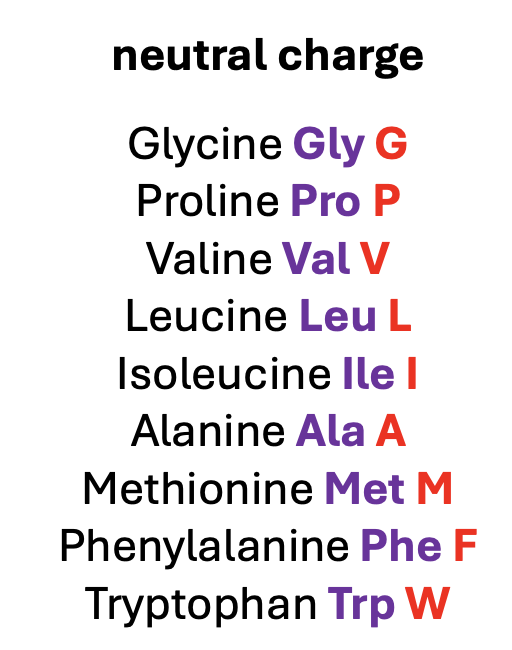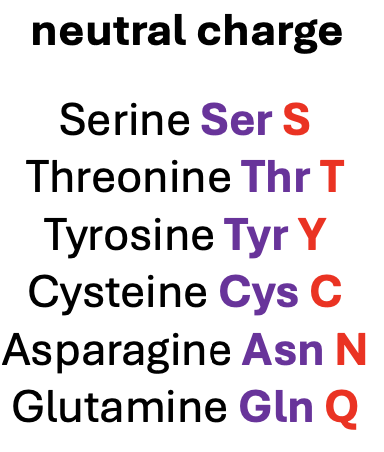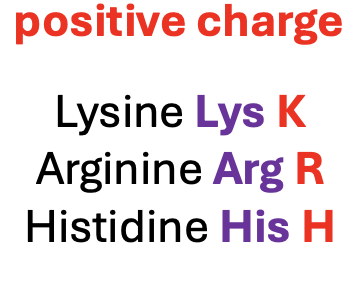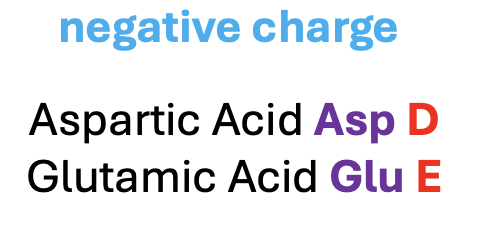Lecture 2 - Main objectives + amino acid nomenclature
1/12
There's no tags or description
Looks like no tags are added yet.
Name | Mastery | Learn | Test | Matching | Spaced |
|---|
No study sessions yet.
13 Terms
Classify amino acids into appropriate groups based upon the structure and properties of their unique R-group side chains.
Amino acids are classified by R-group properties into these main groups:
Nonpolar (hydrophobic) – e.g., Glycine, Alanine, Valine, Leucine, Isoleucine, Methionine, Proline, Phenylalanine, Tryptophan
Polar uncharged – e.g., Serine, Threonine, Asparagine, Glutamine, Tyrosine
Acidic (negatively charged) – e.g., Aspartic acid (Asp), Glutamic acid (Glu)
Basic (positively charged) – e.g., Lysine, Arginine, Histidine
Apply knowledge of the properties of amino acids to understand the structures, properties, and functions of proteins
Amino acid side chain properties—such as hydrophobicity, charge, polarity, and ability to form hydrogen or disulfide bonds—critically influence protein structure and function by dictating intra- and intermolecular interactions during folding. Hydrophobic residues typically localize to the protein core, stabilizing tertiary structure via van der Waals forces, while polar and charged residues orient toward the aqueous environment or engage in ionic and hydrogen bonding. These interactions govern secondary structural elements (e.g., α-helices, β-sheets), facilitate proper tertiary folding, and enable quaternary assembly in multimeric proteins. Functionally, specific residues within active or binding sites determine enzymatic activity, substrate specificity, allosteric regulation, and interactions with other biomolecules, underscoring the central role of amino acid chemistry in protein behavior.
Define protein primary, secondary, tertiary, and quaternary structures.
Primary structure is the linear sequence of amino acids in a polypeptide chain.
Secondary structure refers to localized folding into α-helices or β-sheets stabilized by hydrogen bonds.
Tertiary structure is the overall 3D shape of a single polypeptide, formed by interactions among R-groups.
Quaternary structure is the assembly of multiple polypeptide subunits into a functional protein complex.
Describe the types and nature of bonds and forces that stabilize primary, secondary, tertiary, and quaternary protein structure
Primary structure: stabilized by peptide (covalent) bonds between amino acids.
Secondary structure: stabilized by hydrogen bonds between backbone amide hydrogen and carbonyl oxygen.
Tertiary structure: stabilized by hydrophobic interactions, hydrogen bonds, ionic bonds, van der Waals forces, and disulfide bridges (covalent bonds between cysteines).
Quaternary structure: stabilized by the same forces as tertiary (noncovalent interactions and sometimes disulfide bonds) between subunits.
Predict how changes to a protein’s amino acid primary structure may alter its final structure, properties, and function
Changes to a protein’s primary structure (mutations) can disrupt folding by altering side-chain interactions, potentially leading to misfolding, loss of function, altered binding, or aggregation, depending on the location and type of substitution.
hydrophobic/non-polar neutral charge

hydrophilic/polar neutral charge

hydrophilic/polar

hydrophilic/polar

hydrophobic/non-polar neutral charge
Glycine Gly G
Proline Pro P
Valine
Leucine
Isoleucine
Alanine
Methionine
Phenylalanine
Tryptophan
hydrophobic/non-polar neutral charge
Gly
Pro
Val
Leu
Ille
Ala
Met
Phe
Trp
hydrophilic/polar neutral charge
Serine
Threonine
Tyrosine
Cysteine
Asparagine
Glutamine
hydrophilic/polar neutral charge
Ser
Thr
Tyr
Cys
Asn
Gln
hydrophilic/polar positive charge
Lysine
Arginine
Histidine
hydrophilic/polar positive charge
Lys
Arg
His
hydrophilic/polar negative charge
Aspartic Acid
Glutamic Acid
hydrophilic/polar negative charge
Asp
Glu